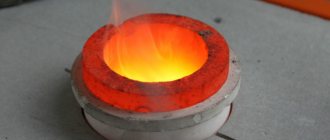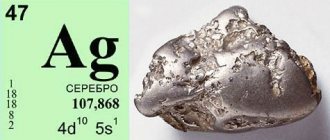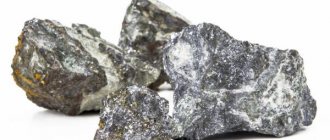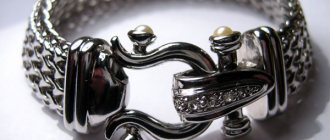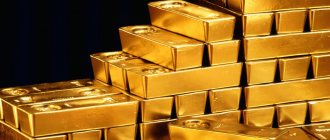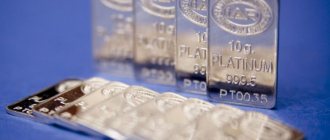Rhodium has a cool white shine. It is more resistant to corrosion than platinum. Rhodium is inferior to silver in its ability to reflect light, but this metal does not fade over time.
Advertising - Continued below
Rhodium was discovered in 1803 by the English scientist William Wollaston. This specialist is known to us because he was the first to make small high-quality diamonds from large stones with defects, and was also able to isolate platinum from ore.
Jewelry uses of rhodium
Due to its physical properties, namely high hardness and light reflectivity, the metal has gained wide popularity among jewelers, who began to use it to coat products.
Since the cost of rhodium is high, it is most often used to coat expensive products. They are usually made from white gold and silver as their base color is silvery white and the rhodium helps to further enhance the natural shine.
Rhodium plated
The rhodium plating procedure involves spraying it with a thin layer, 0.1–25 microns thick. If the work is done efficiently, the product can last for decades.
Silver products processed in this way are often confused with those made of white gold, they shine so much and look no worse, although they are much cheaper.
If a silver piece of jewelry has darkened and lost its shine, you can bring it back to life with a rhodium plating procedure in any jewelry workshop. Usually the coating has to be renewed after 5–10 years, it all depends on the intensity of wear. Brass (jewelry alloy) jewelry can also be treated. But since the procedure is expensive, jewelry is usually subjected to a silver plating process: this is more economical, but the coating will last much less.
Properties of rhodium for jewelry use
Rhodium is five times harder than gold, two times harder than platinum and is only slightly inferior to steel.
It can take on any shade depending on the additives, so the jewelry will have a color from traditional silver to black. If you stop at the latter, this allows you to emphasize the beauty of the gemstone in the jewelry.
Rhodium plating wear
The physical and chemical properties of rhodium are highly valued in jewelry. However, like any metal, it has its advantages and disadvantages.
Emissions curbs cause rhodium prices to skyrocket
The widespread desire to improve air quality has increased purchases of inert metals used in catalytic converters, causing prices for rhodium and its analogue, palladium, to rise. The restart of car trading also contributed to the growth in demand.
As a result, the price of rhodium, already the most expensive precious metal, has risen sharply, but at the same time it is one of the rarest elements on Earth. In 2021, prices jumped to $16,100 per troy ounce, exceeding their previous record level in 2008. In this regard, rhodium outperformed gold, which rose in price by 17%, and palladium, whose price rose by 26%.
According to British chemical company Johnson Matthey PLC, just under 760,000 troy ounces, or 23.5 metric tons, of rhodium were mined in 2019. Almost all of this volume comes from South Africa. This amount of metal would be worth about $12 billion at today's prices. In contrast, according to the US Geological Survey, 3,300 tons of gold were mined last year, which would be worth $190 billion at current prices.
“Demand far exceeds supply,” said Josef Stefans, head of trading at MKS (Switzerland) SA, a precious metals trader. “We are seeing huge demand from Asia.”
Unlike gold, oil or wheat, there is no futures market for rhodium. Mining companies, catalyst makers and automakers are hedging against price swings by entering into private deals with banks such as Standard Chartered PLC. Fund managers are speculating by buying the metal or investing in Xtrackers Physical Rhodium exchange-traded contracts, which are up 142% in 2020.
This market is tiny, so small fluctuations in supply and demand can cause large price fluctuations. The size of the world's rhodium reserves is unknown, but it is believed to be significantly smaller than those of palladium and platinum.
According to British chemical company Johnson Matthey PLC, just under 760,000 troy ounces, or 23.5 metric tons, of rhodium were mined in 2019. Almost all of this volume comes from South Africa. This amount of metal would be worth about $12 billion at today's prices. In contrast, according to the US Geological Survey, 3,300 tons of gold were mined last year, which would be worth $190 billion at current prices.
Rising prices have helped keep some old mines from closing. However, it did not encourage mining companies to open new deposits, since the metal is usually mined in close proximity to large deposits of platinum, whose price has been falling steadily for a long time. Although platinum has shown signs of life recently, prices for this metal have remained virtually unchanged in 2021. Moreover, over the past decade its price has fallen by more than 40%, to $962.70 per troy ounce.
Rising prices for rhodium.
Inflexible supply coupled with rising demand has led to rhodium shortages. Automakers seeking to meet stricter emissions standards have increasingly used precious metal coatings inside catalytic converters. Fashion for SUVs and other vehicles with more powerful engines has also boosted demand for the metal, said David Jolly, head of sales at rhodium miner Anglo American Platinum Ltd.
At high temperatures, rhodium, palladium and platinum catalyze reactions that convert carbon monoxide, hydrocarbons and nitrogen oxides into carbon dioxide, steam and nitrogen, which are harmless to breathe. Hard, reflective rhodium is particularly good at removing nitrogen oxides, which is a priority for regulators in the European Union.
The European trend away from diesel engines following the 2015 Volkswagen AG emissions scandal has also boosted demand, as R. Michael Jones, chief executive of Platinum Group Metals Ltd., which operates a mine near South Africa's border with Botswana, told us. Rhodium and palladium remove harmful substances from gasoline vapors more effectively than platinum.
BASF SE, a German catalyst maker, is working with automakers to cut costs by using more platinum in light-duty gasoline vehicles. However, according to the company, it is unlikely that rhodium can be completely eliminated from automotive catalysts.
Rhodium traders and miners said demand was particularly strong in China, where passenger car sales rose 10% from a year earlier to 2.5 million vehicles in October, according to LCM Automotive Ltd.
The supply of this metal was also subject to restrictions. Earlier this year, a lockdown shut down South African mining operations and disrupted international downstream supply chains.
Earlier in November, a water leak forced Anglo American Platinum to close its treatment plant, forcing the miner to cut its 2021 refined PGM production forecast by 20%. This has fueled speculation among market participants that the company will buy or borrow rhodium to meet its sales obligations. Anglo declined to comment.
Automakers and catalyst makers appear to be stockpiling rhodium in anticipation of a shortage in the new year, said Neil Froneman, chief executive of South African miner Sibanye-Stillwater Ltd. “Demand pressure will become particularly acute in 2022-23,” he said.
James Tatum, co-founder of Valent Asset Management LLC, a metals hedge fund, says rising rhodium sales could presage similar increases in prices in other materials markets.
The transition away from fossil fuels will require large amounts of copper, as well as lesser-known tellurium, used in solar panels, and highly magnetic dysprosium for wind turbines and electric vehicles, he said. He also added that eventually, as production of electric motors begins to dominate over internal combustion engines, the demand for rhodium will fade away.
“This story will end the moment there is no more demand to move from one engine technology to another,” Mr. Tatum said.
https://www.wsj.com/articles/emissions-clampdown-sends-rhodium-prices-on-explosive-rally-11606737904
Found a typo? Select a fragment and press Ctrl+Enter.
Tags: Technology precious metal inert metal rhodium
Previous article Efficient cooling system: graphene tubes for increased performance
Next article Rain business and the “sponge city”
Provided by SendPulse
Likes 0
- 0
- 0
- 0
- 0
Disadvantages of rhodium plating
The main disadvantages of metal that jewelers note:
- Fragility. For this reason, it is not used as a base material in jewelry. When repairing or interacting with other metals, the coating may crack or chip.
- High price. Exceeds the cost of gold several times. The reason for this is the small reserves of the metal and its rarity.
- Over time, the coating wears off and the rhodium plating procedure must be repeated. The duration of wear is affected by the thickness of the applied metal and contact with skin or other products. Therefore, it is important to follow some rules when wearing jewelry, for example, do not get it wet, avoid contact with household chemicals, and remove it at night.
Medicine lost, but chemistry gained
I didn’t think about chemistry, I studied at Oxford, trained as a doctor, and wanted to work at St. George’s Hospital. However, the young doctor was refused, and another was hired. Offended, Wollaston spat on medicine and took up chemistry and physics. It is unknown what medicine has lost, but humanity should be grateful to the scientist for his work with platinum group metals.
Wollaston's work in chemistry is highly appreciated by scientists. We are interested in rhodium. Wollaston is the “father” of rhodium, like palladium. Moreover, Wollaston was not just a scientific cracker, but undoubtedly had a sense of humor. The history of people's acquaintance with palladium is described in more detail in the article on palladium.
Rhodium remained in the shadow of palladium, but in vain. The scientist isolated the metal while working with native platinum, and its composition included palladium, rhodium and other platinum group metals.
Rhodium, a silvery, white-bluish metal, got its name from the ancient Greek word ῥόδον, rose. The metal is white, and the rhodium salts are deep red. Dissolve rhodium in aqua regia and see for yourself.
Benefits of Rhodium Plating
The main advantages of the metal, for which jewelers around the world prefer it:
- Resistant to scratches and damage, which increases the wear resistance of the jewelry.
- Reflective ability that gives platinum shimmer and a noble appearance.
- The shine does not fade over time.
- Silver that has undergone rhodium plating shines longer and does not turn black.
- It is harmless to health as it is hypoallergenic.
Rhodium plating helps to preserve the noble appearance of jewelry for a long time and protects it from various damages.
What is
Rhodium is a noble metal, a platinoid. 45th element of the Mendeleev periodic table.
Rhodium is the most expensive and hardest of the platinoids.
Rhodium looks different:
- Connections – pink, red. Therefore, the new element was called rhodium - in ancient Greek “rose”.
- The metal is bluish-silver, with a cold aristocratic shine.
- The powder is gray to black.
The international designation is Rhodium (Rh).
Deposits, extraction methods
Until the beginning of the third millennium, the “custodian” of most ore reserves was Russia with gigantic deposits of native platinum in the Urals and the Arctic.
Today, Mexico holds the lead in reserves (43%), whose golden sands are oversaturated with rhodium. Next come the deposits of South Africa, Colombia, and the USA.
The annual global production of rhodium does not exceed 31 tons.
The number one metal exporter (80% of volumes) is South Africa.
Rhodium is mined on an industrial scale using a closed (mine) method. It is complicated by the composition of the ore: the metal is mixed with gold, palladium, platinum and silver.
Rhodium in nature
Rhodium is classified as a rare element.
The mass fraction of rhodium in the bowels of the planet is one millionth of a percent. Meteorites are almost 500 times richer.
Pure rhodium ore does not exist; the element is represented by other types:
- Component of platinum ores, gold-bearing sands.
- Element of osmiridium minerals in copper-nickel deposits.
- Native Nevyanskite. The most generous mineral for rhodium (more than 10%).
The independent mineral Rhodium has not been found; it always acts as a companion.
Receiving technology
Obtaining pure metal is a complex multi-step process.
Traditional method
Involves refining platinum ore and extracting the Rhodium component.
Raw materials are transported from the deposit to the processing complex.
Here the precious components and the “empty” are separated:
- The ore is crushed and filled with water and chemical components.
- The mixture is saturated with air under pressure.
- The foam floats up, capturing platinum particles.
- It is removed and sent to dry.
The platinum content reaches 110-990 grams per ton.
The next stage is metallurgy. The concentrated mixture is immersed in ovens and heated to 1500°C. The waste rock is burned and the slag is removed by blowing. The metal content increases to 1400 g per ton.
The final stage is refining. It allows you to isolate other elements from platinum.
The solution left over from the platinum purification process is used to release the rhodium. After exposure to chemical components and calcination, almost pure metallic rhodium is obtained.
The journey from transporting ore from the deposit to obtaining pure rhodium takes five to six months.
From nuclear waste
A technology for producing rhodium from waste from nuclear power plants is being developed. This solves several problems: an increase in the amount of rare metal (there may be more of it in spent nuclear fuel than on the entire planet) plus the environment.
What is it and what is it used for
The substance used for this manipulation is rhodium. This is a noble precious metal of the platinum group, inert and hard. Another advantage is its high reflectivity, thanks to which it shines brightly.
This substance was discovered relatively recently - in 1803. Its content in nature is extremely low. No more than 30 tons of rhodium are mined annually around the world. The metal has a high cost, but at the same time the demand for it is growing every year, as new ways of using it appear.
Types of gold processing with rhodium
The main methods for producing rhodium-plated gold are: immersion and selective. The products are immersed in a solution of rhodium salts, then they are completely covered with a film. Part of the jewelry is processed, for example, the bed under the precious stones - this is a selective method.
Along with this, we can talk about the use of various solutions that provide two types of rhodium treatment:
- Regular, white rhodium plated.
- Black rhodium plating.
Regular rhodium plating for cool shine and silver tone
With the usual method of processing rhodium, products acquire a silvery-white color with a coolish tint.
Black rhodium plated and antique look
Black rhodium plating can be applied to the entire piece of jewelry or to individual parts of the surface. If the decoration has a complex shape, the black layer is deposited unevenly by electrolysis. That's why it begins to resemble ancient rings, rings, and earrings. Applicable primarily to products with dark or black stones.
Rhodium plating can be not only white but also black
Cautions
The properties of the metal have been studied for practical use. The effect on human health and other biological systems has been partially studied.
It was found that rhodium compounds are highly toxic carcinogens. However, the amount of metal in certified jewelry is safe for humans.
If an alloy of rhodium with cadmium (or zinc) is dissolved with hydrochloric acid, filtered, and dried, we obtain a powder. In fact, this is a mixture capable of detonating under normal conditions.
Rhodium plating technology using electrolysis
The most common method of coating jewelry with rhodium film is galvanic, or electrolysis. This is a physical and chemical method that involves the use of the principle of concentration of substances present in a certain solution on electrodes. The process takes place under the influence of electric current.
The technology involves several stages.
Electrolysis of melts and solutions
Step 1: Degreasing and rinsing in various solutions
The preparatory stage comes down to bringing the jewelry to a state that is most suitable for electroplating - coating the metal with a layer of another metal.
At this stage:
- The decoration is cleaned. For this purpose, special solutions can be used.
- Degreasing is carried out using alkaline solutions.
- Rinse several times with hot and then cold water.
- They are kept for a short time, just a few seconds, in hydrochloric acid to increase the adhesive properties of the precious metal.
Adhesion is the property of dissimilar substances to stick to each other due to intermolecular interaction.
The particles penetrate each other, holding the materials together. This is called surface activation.
Having carried out these preparatory procedures, you can be confident in the further success of the galvanic process.
History of discovery
Initially, the metal was considered a waste product, a by-product of platinum production.
The first to become interested in it was in 1803 the British chemist William Wollaston.
He examined platinum from the mines of South America, performing a series of experiments:
- After dissolving the samples with aqua regia, the liquid turned pink-reddish.
- When platinum and palladium precipitated, a purplish powder formed.
- It was fried in hydrogen.
The result was a massive grayish powder.
Physico-chemical characteristics
Rhodium compounds are more resistant to mechanical, chemical stress, and corrosion than platinum or gold:
- Mechanical processing is only possible at 810-900°C.
- Hot aqua regia and strong sulfuric acid can only dissolve powder fractions, and not immediately.
- It can be alloyed without problems with metals (especially platinum group metals).
In air, rhodium oxidizes in the range of 600-800°C. At levels above 800°C, the oxide film disappears from the surface.
| Properties of the atom | |
| Name, symbol, number | Rhodium (Rh), 45 |
| Atomic mass (molar mass) | 102.90550(2) a. e.m. (g/mol) |
| Electronic configuration | [Kr] 4d8 5s1 |
| Atomic radius | 134 pm |
| Chemical properties | |
| Covalent radius | 125 pm |
| Ion radius | (+3e)68 pm |
| Electronegativity | 2.28 (Pauling scale) |
| Electrode potential | +0.8v |
| Oxidation states | 5, 4, 3, 2, 1, 0 |
| Ionization energy (first electron) | 719.5 (7.46) kJ/mol (eV) |
| Thermodynamic properties of a simple substance | |
| Density (at normal conditions) | 12.41 g/cm³ |
| Melting temperature | 1963°C |
| Boiling temperature | 3727°C |
| Ud. heat of fusion | 21.8 kJ/mol |
| Ud. heat of vaporization | 494 kJ/mol |
| Molar heat capacity | 24.95 J/(K mol) |
| Molar volume | 8.3 cm³/mol |
| Crystal lattice of a simple substance | |
| Lattice structure | cubic face-centered |
| Lattice parameters | a=3.803 Å |
| Debye temperature | 480K |
| Other characteristics | |
| Thermal conductivity | (300 K) 150 W/(m K) |
| CAS number | 7440-16-6 |
Natural Rhodium has no formula because it consists only of the 103Rh isotope.

